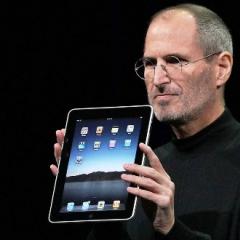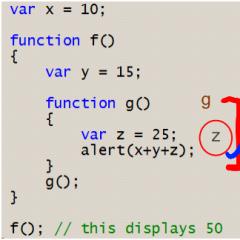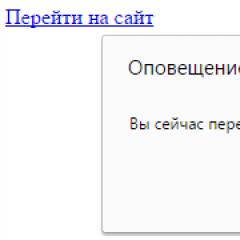Blue shortcuts on the desktop. How to restore transparency of labels? Notepad icons are displayed on the desktop instead of shortcuts. Why have shortcuts on the desktop increased?
When working on a computer, many users need to increase or decrease desktop icons. The level of vision of all people is different, so it will be more comfortable for the user to adjust the display of the size of the Desktop icons to suit their needs.
By default, the size of Desktop icons is adjusted depending on the monitor screen resolution on a particular computer. The dimensions of all desktop elements can be changed if necessary.
In the Windows operating system, you can change the size of icons on the Desktop using standard system tools. These methods work on Windows 10, Windows 8, and Windows 7 operating systems.
Let's look at two options separately: how to make the icons on the Desktop smaller, and how to enlarge the icons on the Windows Desktop. We will consider changing the size of Desktop icons using the Windows 10 operating system as an example.
The easiest way to make your desktop icons smaller is to use your keyboard keys. This is the simplest and easiest way to change the size of icons on your computer desktop.
How to make icons smaller on Windows 10 (1 method)
Open the Desktop, press the “Ctrl” key on your keyboard, and then scroll the mouse wheel down (toward you). You will see that the icons on the Windows 10 desktop decrease in size. This way, you can choose a more appropriate icon size option for yourself.
How to make desktop icons smaller (method 2)
After right-clicking on the Desktop, click on “View” in the context menu, and then select “Small Icons”.
All icons on the desktop have become small and decreased in size.
How to enlarge icons on the Windows desktop (1 method)
You can use a keyboard shortcut to increase the size of your desktop icons. With the Desktop open, press the Ctrl key and then scroll the mouse wheel up (away from you). After this, the icons will increase in size, depending on the degree of scrolling of the mouse wheel.
Increasing the size of desktop icons (method 2)
On the Desktop, click on the right mouse button. In the context menu that opens, select “View” and then “Large Icons.”

This is not a customizable way to make icons larger.
How to enlarge desktop icons in Windows 10 (3rd method)
In Windows 10, right-click on the Desktop and select “Display Settings” from the context menu.
In the “Display” section, under “Change text, apps, and other items: 100% (recommended),” move the slider on the scale to the desired position.

The size of the Desktop elements will change depending on the position of the slider on the scale.
In addition, you can enlarge a specific part of the monitor screen using .
Conclusions of the article
The user can easily and simply change the size of the icons on the Desktop of their computer. Windows Desktop icons can be made smaller or larger using keyboard shortcuts, or by using Display Options settings.
Just yesterday I was visiting a friend and was very surprised when I saw huge application and folder icons on her 21-inch screen (Windows 7 OS). I asked her: “Is it convenient to work with such a desktop?” And do you know what the girl answered me? It's inconvenient, but she doesn't know how to change the size of the icons! If you also don’t know how to do this, then this article is definitely written for you.
I’ll say right away: to solve this issue, you can use one of three well-known methods, and which one is more suitable for you can be found out by trial and error. I'll start with the easiest method for me.
First method
Method one and the simplest: go to work and minimize all windows. Next, take the mouse in your hands, hold down the CTRL key and slowly move the mouse wheel to one side until we achieve the desired result. By moving the wheel away from you, the size of the icons will increase, and towards you - decrease. Try it and you will be pleasantly surprised. Just don't make sudden movements, otherwise the icons will become so huge that they won't fit on the screen.

Second method
The second method is not much more complicated than the first, but with its help you can only set the icons to a fixed size. To do this, minimize all windows on the desktop, right-click, hover over the “View” subsection and select the icon size (large, regular or small).

Third method
Finally, the third method. Open the desktop again and minimize the windows. Right-click on the mouse and go to the “Personalization” subsection. A window will open for you to configure images on your computer. In the lower left part of the window there is a “Screen” link that you need to click on.

This brings us to the “Screen Reader Ease” section. Here you can increase the size of elements on the screen by percentage, ranging from 100% to 150%. That is, with this function you can change the size not only of the icons themselves, but also of any other elements.

As you can see, this procedure is extremely simple and will not take you much time (no more than two to three minutes). As for ease of use, I would recommend using the first, simplest method.
The sizes of icons that are present on the desktop cannot always satisfy users. It all depends on the parameters of the monitor or laptop screen, as well as on individual preferences. Some people may find the icons too large, while others may find the icons too big. Therefore, all versions of Windows provide the ability to independently change their size.
There are several ways to resize desktop shortcuts. The instructions on how to reduce desktop icons in Windows 7 and the latest versions of this OS are almost identical. In Windows XP, this problem is solved a little differently.
Method 1: Mouse Wheel
This is the easiest way to make desktop shortcuts larger or smaller. To do this, you need to hold down the key "Ctrl and at the same time start rotating the mouse wheel. When rotating away from you, there will be an increase, and when rotating towards you, there will be a decrease. All you have to do is achieve the size you want.
Getting acquainted with this method, many readers may ask: what about laptop owners who do not use a mouse? These users need to know how the mouse wheel is simulated on a touchpad. This is done with two fingers. Moving them from the center to the corners of the touchpad simulates forward rotation, and moving from the corners to the center simulates backward rotation.
Thus, in order to enlarge the icons, you need to hold down the key "Ctrl", and with the other hand on the touchpad make a movement from the corners to the center. 
To make the icons smaller, move in the opposite direction.
Method 2: Context Menu
This method is as simple as the previous one. In order to achieve the desired goal, you need to right-click on the free space of the desktop to open the context menu and go to the section "View".
Then all you have to do is select the desired icon size: regular, large, or small. 
The disadvantages of this method include the fact that the user is offered only three fixed icon sizes to choose from, but for most this is more than enough.
Method 3: For Windows XP
You cannot increase or decrease the size of icons using the mouse wheel in Windows XP. To do this, you need to change the settings in the display properties. This is done in several steps.

Windows XP also provides more flexible settings for the size of desktop icons. To do this you need:

Now all you have to do is press the button OK and make sure that your desktop shortcuts are larger (or smaller, depending on your preference).
At this point, your acquaintance with ways to enlarge icons on your desktop can be considered complete. As you can see, even an inexperienced user can cope with this task.
Despite the fact that the Windows operating system has relatively (for example, when compared with the capabilities of GNU/Linux) scant possibilities for customizing the graphical interface, some of its elements can still be changed. In particular, it is possible to change the size of icons on the desktop. But some PC users who are not aware of the existence of the corresponding function may be perplexed when the icons on the screen become huge. In this regard, they open a search engine or go to a forum and ask why the icons on the desktop have become large.
Some of those who have encountered the phenomenon of increased desktop icons immediately assume that some kind of malicious program has entered their computer. However, of course, this is not the case. Why would a “virus” do such things? The goal of malware now is either to steal personal data or to introduce intrusive advertising.
In fact, the reason why the icons became larger or, on the contrary, smaller, most often lies in the fact that the user himself accidentally changed them. This could happen, for example, when the desktop area was active and the user held down the CTRL key and scrolled the mouse wheel up or down.
How to return desktop icons to normal size
![]()
Why have my desktop icons gotten big? As we found out, the reason for the phenomenon in question is quite trivial. Actually, that’s why the “problem” can be fixed very easily.
First option How to return desktop icons to their normal appearance (size), suggests:
- Activating the desktop area (minimize/close all windows and click on any empty space on the desktop);
- Holding down the CTRL key;
- Scroll the mouse wheel down (to reduce the size of the icons) and up (to increase them).
Another variant, resizing icons on the Windows desktop involves performing the following steps:
- Right-click (left for left-handers) on any empty (not icon) area of the desktop;
- Selecting the “View” item in the context menu;
- Select “Regular icons” (standard size) from the pop-up submenu.
After this, the desktop icons are guaranteed to change their large size to the one specified by the user. The actions described in both instructions lead to the desired result in all modern versions of Windows (10, 8, 7 and even Vista).
You should be aware that after changing the size of the icons, they may change their location slightly. For example, if the trash icon was in the lower right corner, right next to the taskbar, it may move a little to the left and up. This applies to all icons. To return them to their original location, you just need to drag the icons to the areas where they were previously located.

Hello, dear readers and guests of our blog.
What I love about Windows is that it keeps us computer users from getting bored. What can we say about some Linux or Mac OS X, which they installed and forgot about glitches on the part of the system. But the Windows operating system will not give us such a bug.
Today my friend asked me to look at his computer with Windows 7 installed. His little son Dimas played on it, and somehow managed to launch all the .exe programs using notepad. Now, instead of the usual file and program icons, you can see notepad icons.
Recovering a file association violation
In this article, as you guessed, we will talk about how to fix launching notepad instead of shortcuts, please note that someone may launch via word, paint, or even have a standard image of an unassociated file (unknown). In any case, there will be one solution.
Let me say in advance that this problem lies in Windows registry crash.
Why do you ask: did I call it a glitch? Everything is very simple - the Windows OS itself should return everything to its place at the next reboot. If this does not happen, then we have another failure. Well, let's fix the system bug.

As you understand, the above-described failure occurred in the registry somehow (and there can be many reasons, ranging from viruses to user error).
To fix this problem, you will need to import the default registry branches responsible for these parameters.
- restoration of label association
- restoring file association (files with .exe extension)
Simply download these files and double-click on each of them, then restart your computer. After the operation, everything should work. As you can see, everything is very simple.
Read also:
Another way
Also, if this method did not help, you can try another solution.
We perform the following manipulations:
Start, in the execute line we type regedit and press Enter, go to the registry editor and find the branch: HKEY_LOCAL_MACHINE\ SOFTWARE\ Microsoft \Windows\ CurrentVersion\ Explorer and delete Shell Icons after which we reboot.



